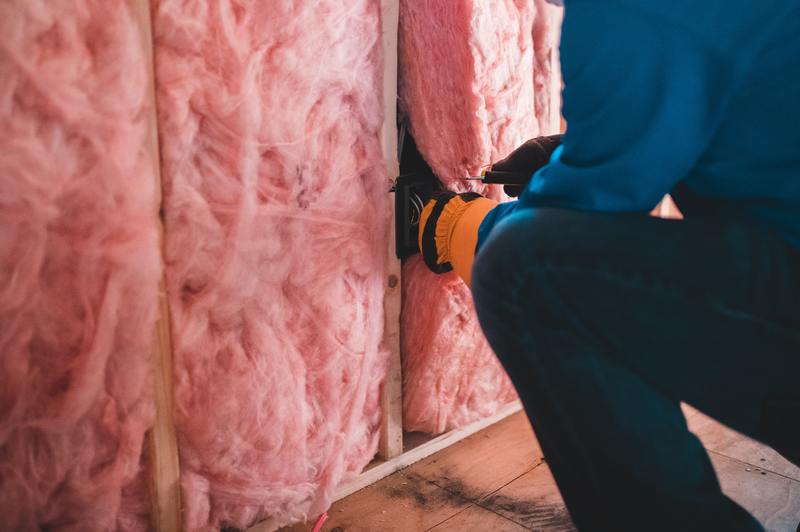At one point, you might have asked “what insulation is least likely to be damaged by water.” This is a common problem if you live in rainy areas. Insulation sheets are often used as an excellent cold, heat, and moisture insulation material.
Since it also serves as a sound barrier, it effectively absorbs sound from all directions. This article will give everything you need to know about different types of insulation and the durable ones that can stand even in water.

What Is Insulation?
Insulation is any material used to fill spaces in your home, including small gaps, cracks, and hard-to-reach areas behind walls, above ceilings, and so on. This is to minimize heat movement through reflection and absorption.
Insulation comes in various forms, including soundproofing insulation, electrical insulation, and thermal insulation. When it comes to insulation for your home, thermal insulation is the type that improves energy efficiency and comfort. Thermal insulation is a material that reduces and slows heat loss or gain by forming a barrier between two locations with considerable temperature differences.
How does insulation work?
Heat naturally travels from warmer to more excellent locations. Heat goes directly from warm spaces (like your home) to outdoors and unheated lengths during the winter. Heat transfers from the warm exterior to the colder interior of your home during the summer months.
Insulation slows the transfer of heat from a hot to a cooler environment. Insulation improves your home’s energy efficiency by limiting the amount of heat that escapes in the winter and preventing it from becoming overly hot in the summer (retaining the cold air and keeping the interior comfortable).
Insulation can improve your home’s comfort levels by keeping a stable, uniform temperature from room to room when appropriately placed. Insulation improves the efficiency of energy for your home, cutting your heating and cooling costs dramatically.
Different Types Of Insulation
There are a variety of thermal insulation options available, including:
Fiberglass
Fiberglass insulation is one of the most common types of insulation, and it comes in rolls and batts that can be put as a blanket system.
Cellulose
Cellulose insulation is one of the most eco-friendly types of insulation available, with up to 80% recycled content. It’s one of the best types of soundproofing insulation.
Spray foam
Spray foam insulation is excellent for all the minor cracks, gaps, and crevices behind your walls, and it can help minimize air leaks that can drive up your energy expenses.
Radiant barrier
Radiant barrier insulation is placed in the attic, directly beneath the roof, to assist your home to reflect heat from the sun rather than absorb it.
Rigid foam
Rigid foam insulation, also known as rigid board insulation, comes in a cuttable foam panel. It’s primarily employed in the insulation of new buildings.
Rockwool
Rockwool (or mineral wool) insulation is made from rocks and minerals spun into tiny, high-temperature-resistant fibers and utilized in various applications.
Where Can I Insulate?
Attic insulation
Attics are a fantastic site to insulate because they are one of the most common sources of energy loss in homes.
Wall insulation
Walls are another significant source of energy loss and must be insulated to improve home energy efficiency. You’ll need more than one sort of insulation for the walls, much like the attic.
Insulation for basements
Even though your basement is unfinished, it has a lot of energy-saving possibilities. Proper basement insulation can save you hundreds of dollars per year.
Crawl space insulation
Like basement insulation, crawl space insulation is often overlooked. Although not everyone utilizes their crawl space daily, crawl space insulation can prevent heat from escaping or leaking into your home.
What is the best type of insulation to stand water damage?
Insulation, like any other investment, raises the value of your home. Because different types of insulation have additional benefits and drawbacks, the “best” insulation for your home could be a combination of them.
Cellulose is made out of 80 percent recycled materials, it is a popular choice among environmentalists, and this is very durable to stand water.
Fiberglass is simple, energy-efficient, and widely used. Fiberglass is a good sound barrier and offers better indoor air quality. Since this material is made up of tiny glass strands, it does not absorb water.
Can insulation be waterproofed?
Yes, and insulations like the ones for the basement can even be waterproofed in particular. Waterproofing can also help in crawl spaces. There’s a distinction to be made between “encapsulating” and “insulating” a crawl space, and what you need depends on plumbing, flooring, and other factors.
Conclusion
Insulations like Fiberglass help you keep the desired temperature in your home and enable you to save money on energy. Foam board insulation has a high R-value and a low perm rating because water does not quickly disperse through the material.
Hopefully, we gave you the answer to the question, “what insulation is least likely to be damaged by water.” We hope you can apply these tips to choose the right insulation for your home.
